International Financial Management: The Russian Ruble Crisis of 1998
VerifiedAdded on 2020/04/21
|21
|5493
|81
Report
AI Summary
This report provides a comprehensive analysis of the 1998 Ruble crisis in Russia, examining the economic and political factors that contributed to the crisis. It delves into the historical context, including the transition from communism to a free market economy, the impact of fixed exchange rates, and the influence of the Asian Financial Crisis. The report explores the role of political instability, including the war in Chechnya and the dismissal of the Prime Minister, and the responses of the government, including seeking assistance from the International Monetary Fund and attempting to maintain a fixed exchange rate. It also discusses the impact of declining productivity and the strikes by coal miners. Furthermore, the report touches upon the left opposition to anti-crisis policies. The report concludes by highlighting the key factors that led to the crisis and the long-term consequences for the Russian economy. This report is a valuable resource for students studying international finance and economics, and is available on Desklib for further study.
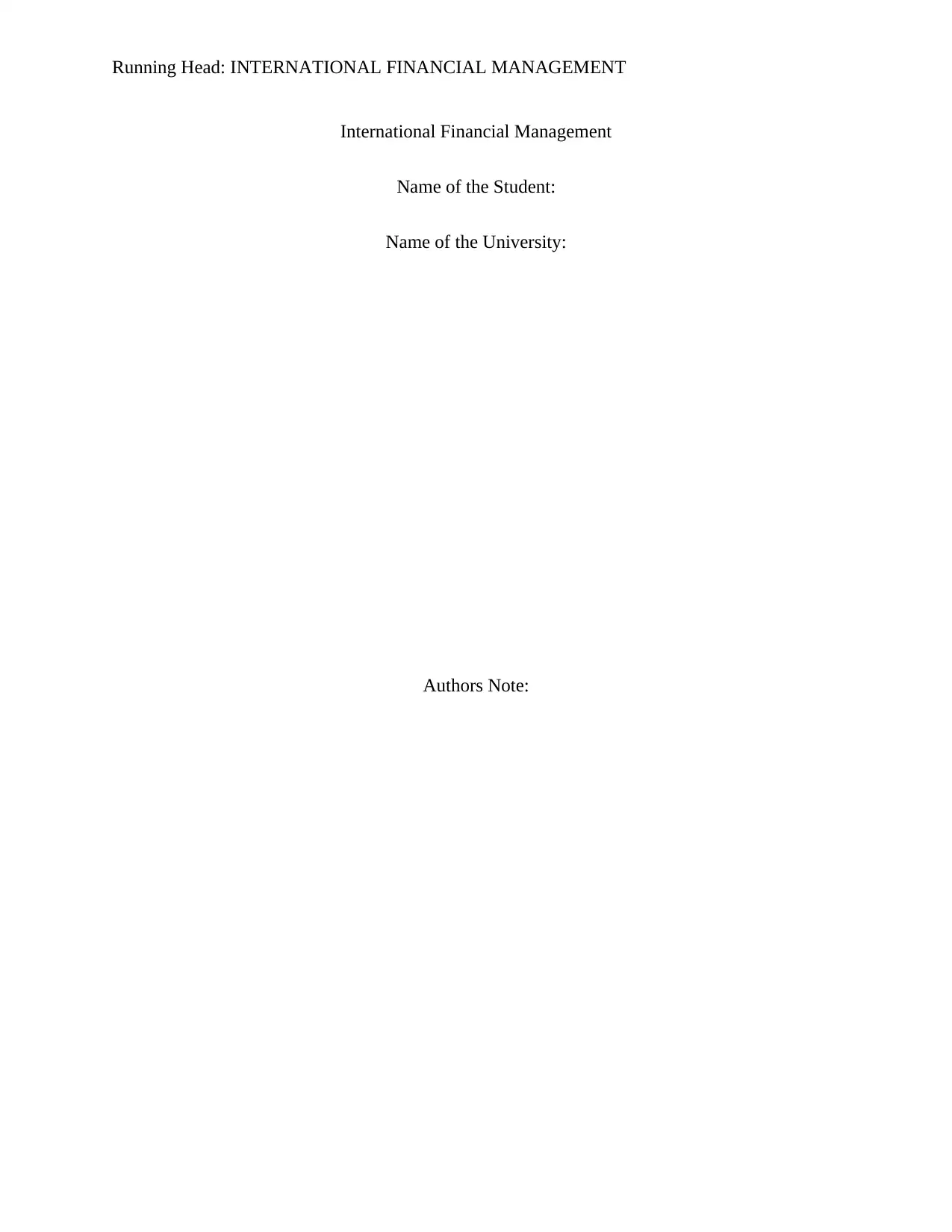
Running Head: INTERNATIONAL FINANCIAL MANAGEMENT
International Financial Management
Name of the Student:
Name of the University:
Authors Note:
International Financial Management
Name of the Student:
Name of the University:
Authors Note:
Paraphrase This Document
Need a fresh take? Get an instant paraphrase of this document with our AI Paraphraser
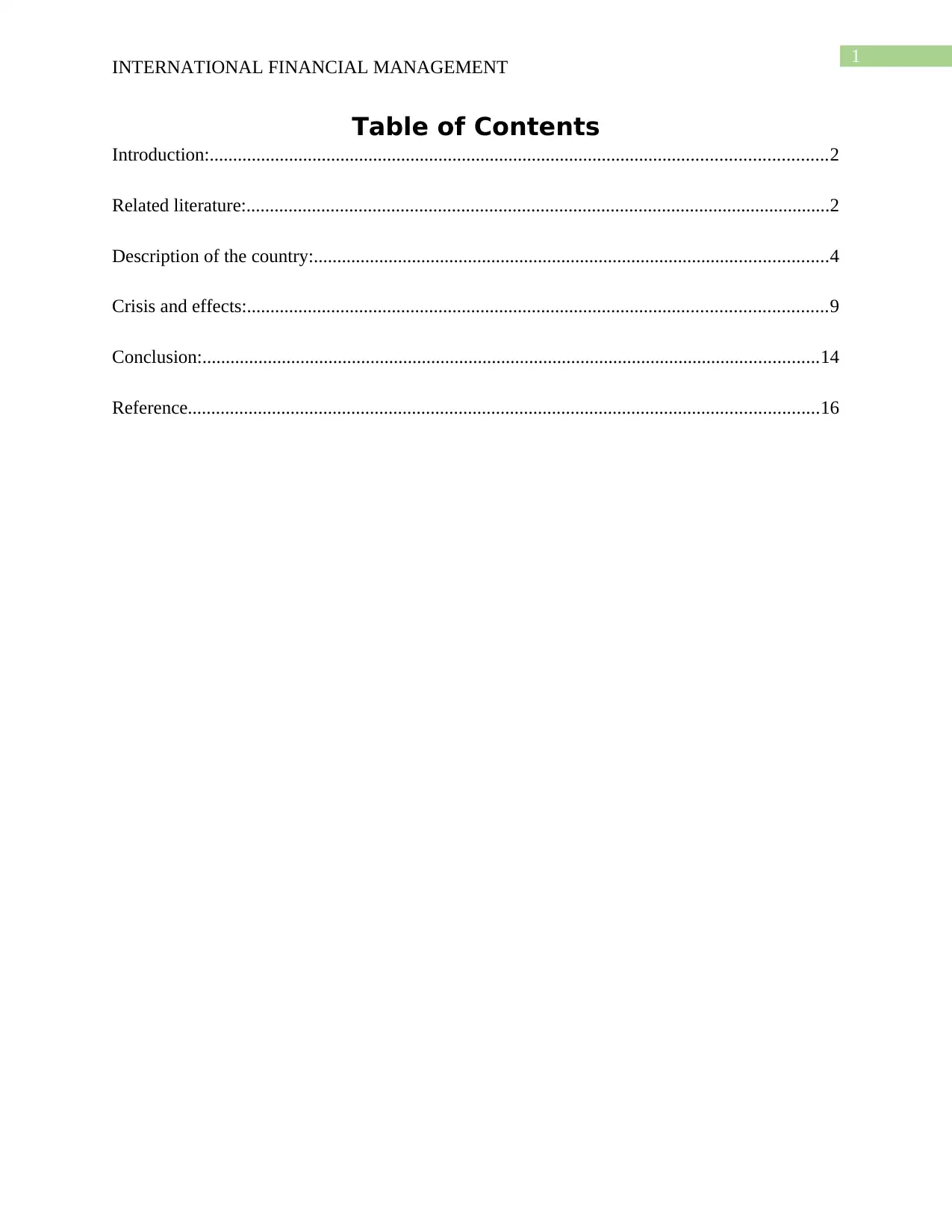
1
INTERNATIONAL FINANCIAL MANAGEMENT
Table of Contents
Introduction:....................................................................................................................................2
Related literature:.............................................................................................................................2
Description of the country:..............................................................................................................4
Crisis and effects:............................................................................................................................9
Conclusion:....................................................................................................................................14
Reference.......................................................................................................................................16
INTERNATIONAL FINANCIAL MANAGEMENT
Table of Contents
Introduction:....................................................................................................................................2
Related literature:.............................................................................................................................2
Description of the country:..............................................................................................................4
Crisis and effects:............................................................................................................................9
Conclusion:....................................................................................................................................14
Reference.......................................................................................................................................16
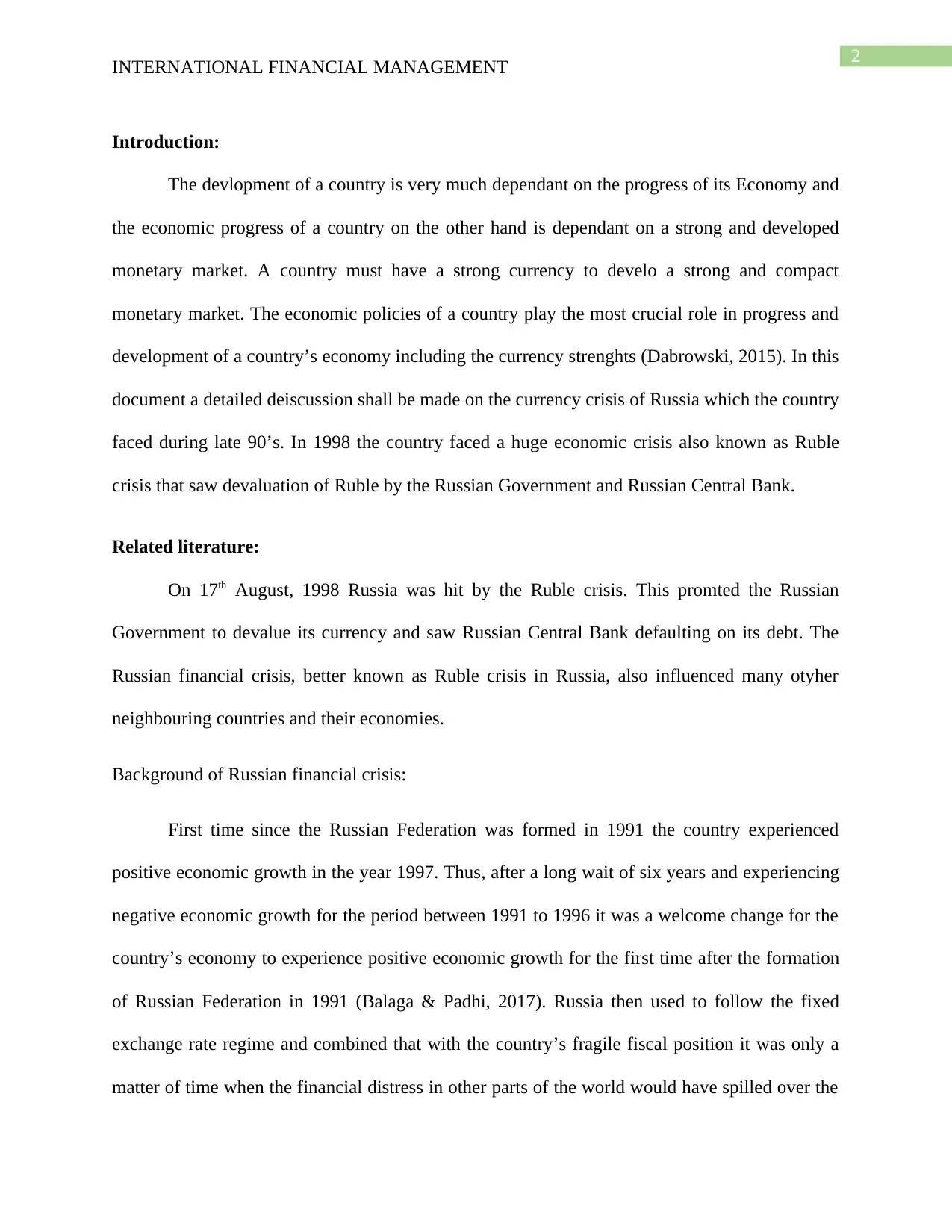
2
INTERNATIONAL FINANCIAL MANAGEMENT
Introduction:
The devlopment of a country is very much dependant on the progress of its Economy and
the economic progress of a country on the other hand is dependant on a strong and developed
monetary market. A country must have a strong currency to develo a strong and compact
monetary market. The economic policies of a country play the most crucial role in progress and
development of a country’s economy including the currency strenghts (Dabrowski, 2015). In this
document a detailed deiscussion shall be made on the currency crisis of Russia which the country
faced during late 90’s. In 1998 the country faced a huge economic crisis also known as Ruble
crisis that saw devaluation of Ruble by the Russian Government and Russian Central Bank.
Related literature:
On 17th August, 1998 Russia was hit by the Ruble crisis. This promted the Russian
Government to devalue its currency and saw Russian Central Bank defaulting on its debt. The
Russian financial crisis, better known as Ruble crisis in Russia, also influenced many otyher
neighbouring countries and their economies.
Background of Russian financial crisis:
First time since the Russian Federation was formed in 1991 the country experienced
positive economic growth in the year 1997. Thus, after a long wait of six years and experiencing
negative economic growth for the period between 1991 to 1996 it was a welcome change for the
country’s economy to experience positive economic growth for the first time after the formation
of Russian Federation in 1991 (Balaga & Padhi, 2017). Russia then used to follow the fixed
exchange rate regime and combined that with the country’s fragile fiscal position it was only a
matter of time when the financial distress in other parts of the world would have spilled over the
INTERNATIONAL FINANCIAL MANAGEMENT
Introduction:
The devlopment of a country is very much dependant on the progress of its Economy and
the economic progress of a country on the other hand is dependant on a strong and developed
monetary market. A country must have a strong currency to develo a strong and compact
monetary market. The economic policies of a country play the most crucial role in progress and
development of a country’s economy including the currency strenghts (Dabrowski, 2015). In this
document a detailed deiscussion shall be made on the currency crisis of Russia which the country
faced during late 90’s. In 1998 the country faced a huge economic crisis also known as Ruble
crisis that saw devaluation of Ruble by the Russian Government and Russian Central Bank.
Related literature:
On 17th August, 1998 Russia was hit by the Ruble crisis. This promted the Russian
Government to devalue its currency and saw Russian Central Bank defaulting on its debt. The
Russian financial crisis, better known as Ruble crisis in Russia, also influenced many otyher
neighbouring countries and their economies.
Background of Russian financial crisis:
First time since the Russian Federation was formed in 1991 the country experienced
positive economic growth in the year 1997. Thus, after a long wait of six years and experiencing
negative economic growth for the period between 1991 to 1996 it was a welcome change for the
country’s economy to experience positive economic growth for the first time after the formation
of Russian Federation in 1991 (Balaga & Padhi, 2017). Russia then used to follow the fixed
exchange rate regime and combined that with the country’s fragile fiscal position it was only a
matter of time when the financial distress in other parts of the world would have spilled over the
⊘ This is a preview!⊘
Do you want full access?
Subscribe today to unlock all pages.

Trusted by 1+ million students worldwide
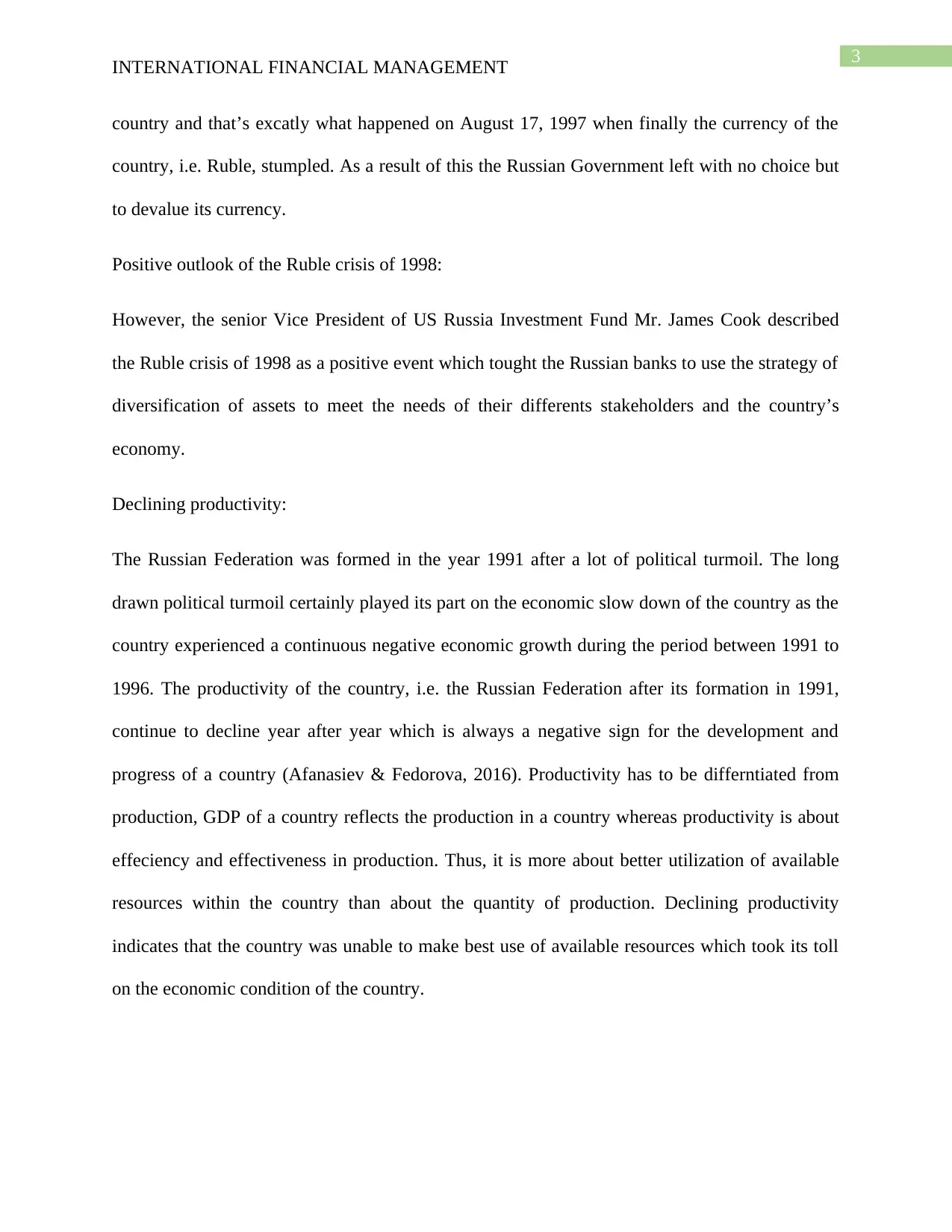
3
INTERNATIONAL FINANCIAL MANAGEMENT
country and that’s excatly what happened on August 17, 1997 when finally the currency of the
country, i.e. Ruble, stumpled. As a result of this the Russian Government left with no choice but
to devalue its currency.
Positive outlook of the Ruble crisis of 1998:
However, the senior Vice President of US Russia Investment Fund Mr. James Cook described
the Ruble crisis of 1998 as a positive event which tought the Russian banks to use the strategy of
diversification of assets to meet the needs of their differents stakeholders and the country’s
economy.
Declining productivity:
The Russian Federation was formed in the year 1991 after a lot of political turmoil. The long
drawn political turmoil certainly played its part on the economic slow down of the country as the
country experienced a continuous negative economic growth during the period between 1991 to
1996. The productivity of the country, i.e. the Russian Federation after its formation in 1991,
continue to decline year after year which is always a negative sign for the development and
progress of a country (Afanasiev & Fedorova, 2016). Productivity has to be differntiated from
production, GDP of a country reflects the production in a country whereas productivity is about
effeciency and effectiveness in production. Thus, it is more about better utilization of available
resources within the country than about the quantity of production. Declining productivity
indicates that the country was unable to make best use of available resources which took its toll
on the economic condition of the country.
INTERNATIONAL FINANCIAL MANAGEMENT
country and that’s excatly what happened on August 17, 1997 when finally the currency of the
country, i.e. Ruble, stumpled. As a result of this the Russian Government left with no choice but
to devalue its currency.
Positive outlook of the Ruble crisis of 1998:
However, the senior Vice President of US Russia Investment Fund Mr. James Cook described
the Ruble crisis of 1998 as a positive event which tought the Russian banks to use the strategy of
diversification of assets to meet the needs of their differents stakeholders and the country’s
economy.
Declining productivity:
The Russian Federation was formed in the year 1991 after a lot of political turmoil. The long
drawn political turmoil certainly played its part on the economic slow down of the country as the
country experienced a continuous negative economic growth during the period between 1991 to
1996. The productivity of the country, i.e. the Russian Federation after its formation in 1991,
continue to decline year after year which is always a negative sign for the development and
progress of a country (Afanasiev & Fedorova, 2016). Productivity has to be differntiated from
production, GDP of a country reflects the production in a country whereas productivity is about
effeciency and effectiveness in production. Thus, it is more about better utilization of available
resources within the country than about the quantity of production. Declining productivity
indicates that the country was unable to make best use of available resources which took its toll
on the economic condition of the country.
Paraphrase This Document
Need a fresh take? Get an instant paraphrase of this document with our AI Paraphraser
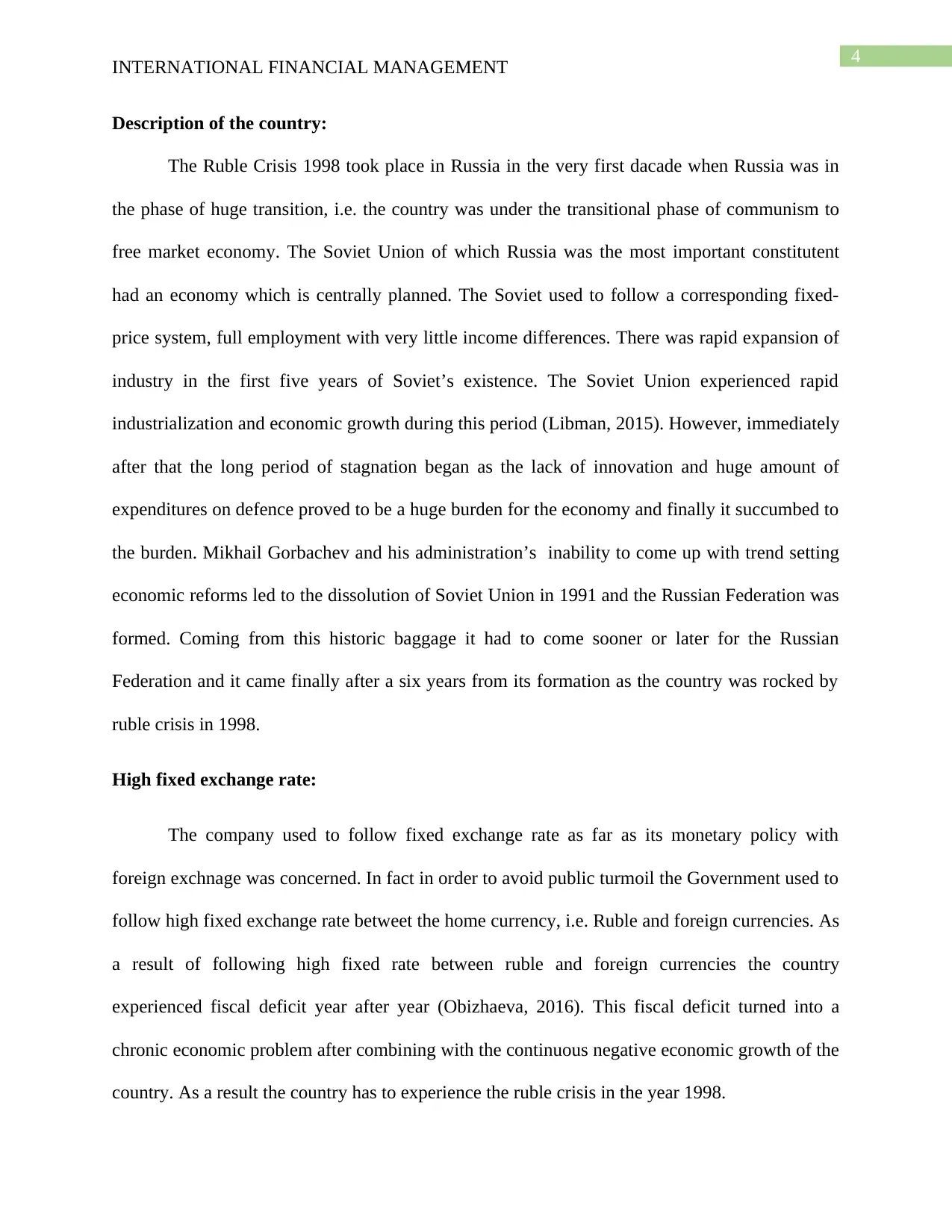
4
INTERNATIONAL FINANCIAL MANAGEMENT
Description of the country:
The Ruble Crisis 1998 took place in Russia in the very first dacade when Russia was in
the phase of huge transition, i.e. the country was under the transitional phase of communism to
free market economy. The Soviet Union of which Russia was the most important constitutent
had an economy which is centrally planned. The Soviet used to follow a corresponding fixed-
price system, full employment with very little income differences. There was rapid expansion of
industry in the first five years of Soviet’s existence. The Soviet Union experienced rapid
industrialization and economic growth during this period (Libman, 2015). However, immediately
after that the long period of stagnation began as the lack of innovation and huge amount of
expenditures on defence proved to be a huge burden for the economy and finally it succumbed to
the burden. Mikhail Gorbachev and his administration’s inability to come up with trend setting
economic reforms led to the dissolution of Soviet Union in 1991 and the Russian Federation was
formed. Coming from this historic baggage it had to come sooner or later for the Russian
Federation and it came finally after a six years from its formation as the country was rocked by
ruble crisis in 1998.
High fixed exchange rate:
The company used to follow fixed exchange rate as far as its monetary policy with
foreign exchnage was concerned. In fact in order to avoid public turmoil the Government used to
follow high fixed exchange rate betweet the home currency, i.e. Ruble and foreign currencies. As
a result of following high fixed rate between ruble and foreign currencies the country
experienced fiscal deficit year after year (Obizhaeva, 2016). This fiscal deficit turned into a
chronic economic problem after combining with the continuous negative economic growth of the
country. As a result the country has to experience the ruble crisis in the year 1998.
INTERNATIONAL FINANCIAL MANAGEMENT
Description of the country:
The Ruble Crisis 1998 took place in Russia in the very first dacade when Russia was in
the phase of huge transition, i.e. the country was under the transitional phase of communism to
free market economy. The Soviet Union of which Russia was the most important constitutent
had an economy which is centrally planned. The Soviet used to follow a corresponding fixed-
price system, full employment with very little income differences. There was rapid expansion of
industry in the first five years of Soviet’s existence. The Soviet Union experienced rapid
industrialization and economic growth during this period (Libman, 2015). However, immediately
after that the long period of stagnation began as the lack of innovation and huge amount of
expenditures on defence proved to be a huge burden for the economy and finally it succumbed to
the burden. Mikhail Gorbachev and his administration’s inability to come up with trend setting
economic reforms led to the dissolution of Soviet Union in 1991 and the Russian Federation was
formed. Coming from this historic baggage it had to come sooner or later for the Russian
Federation and it came finally after a six years from its formation as the country was rocked by
ruble crisis in 1998.
High fixed exchange rate:
The company used to follow fixed exchange rate as far as its monetary policy with
foreign exchnage was concerned. In fact in order to avoid public turmoil the Government used to
follow high fixed exchange rate betweet the home currency, i.e. Ruble and foreign currencies. As
a result of following high fixed rate between ruble and foreign currencies the country
experienced fiscal deficit year after year (Obizhaeva, 2016). This fiscal deficit turned into a
chronic economic problem after combining with the continuous negative economic growth of the
country. As a result the country has to experience the ruble crisis in the year 1998.
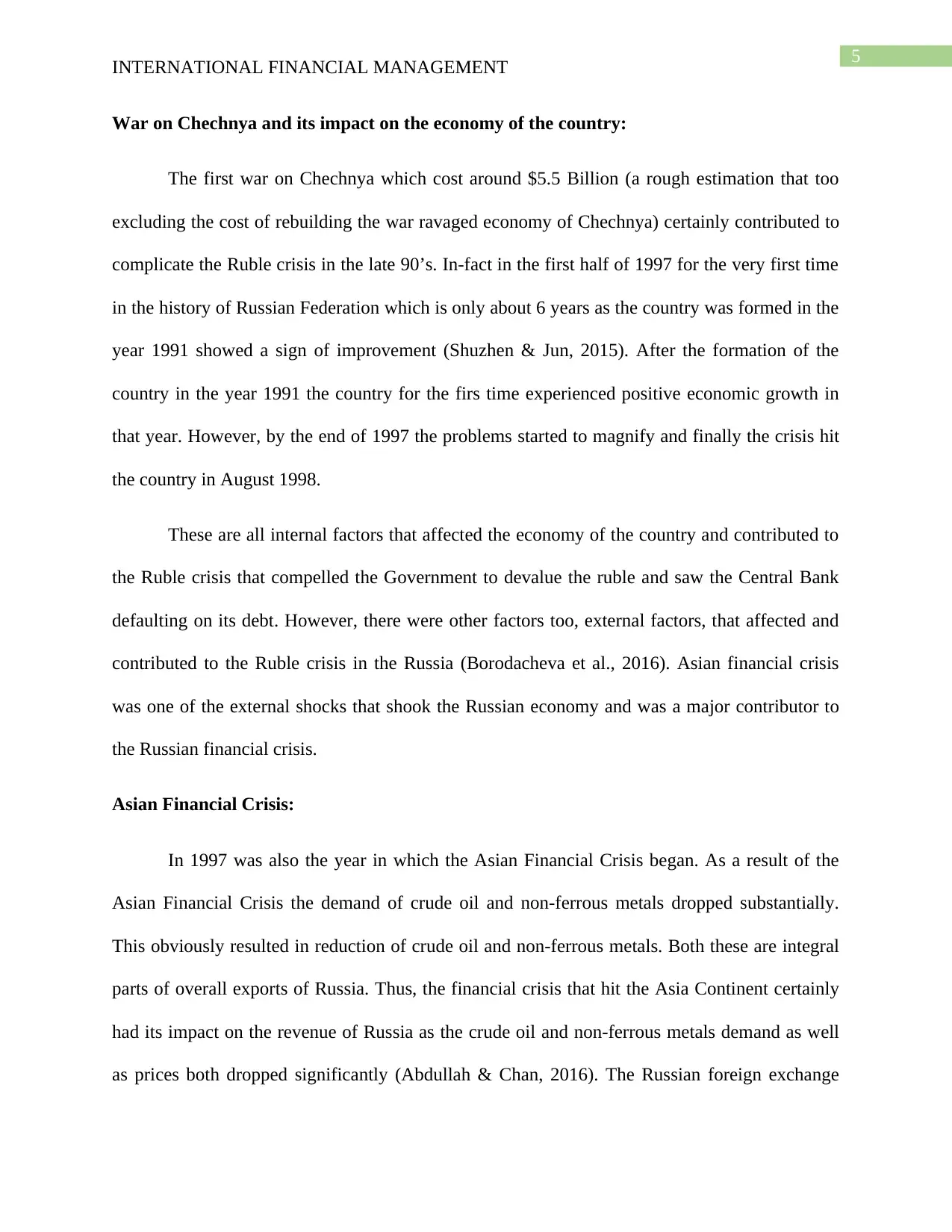
5
INTERNATIONAL FINANCIAL MANAGEMENT
War on Chechnya and its impact on the economy of the country:
The first war on Chechnya which cost around $5.5 Billion (a rough estimation that too
excluding the cost of rebuilding the war ravaged economy of Chechnya) certainly contributed to
complicate the Ruble crisis in the late 90’s. In-fact in the first half of 1997 for the very first time
in the history of Russian Federation which is only about 6 years as the country was formed in the
year 1991 showed a sign of improvement (Shuzhen & Jun, 2015). After the formation of the
country in the year 1991 the country for the firs time experienced positive economic growth in
that year. However, by the end of 1997 the problems started to magnify and finally the crisis hit
the country in August 1998.
These are all internal factors that affected the economy of the country and contributed to
the Ruble crisis that compelled the Government to devalue the ruble and saw the Central Bank
defaulting on its debt. However, there were other factors too, external factors, that affected and
contributed to the Ruble crisis in the Russia (Borodacheva et al., 2016). Asian financial crisis
was one of the external shocks that shook the Russian economy and was a major contributor to
the Russian financial crisis.
Asian Financial Crisis:
In 1997 was also the year in which the Asian Financial Crisis began. As a result of the
Asian Financial Crisis the demand of crude oil and non-ferrous metals dropped substantially.
This obviously resulted in reduction of crude oil and non-ferrous metals. Both these are integral
parts of overall exports of Russia. Thus, the financial crisis that hit the Asia Continent certainly
had its impact on the revenue of Russia as the crude oil and non-ferrous metals demand as well
as prices both dropped significantly (Abdullah & Chan, 2016). The Russian foreign exchange
INTERNATIONAL FINANCIAL MANAGEMENT
War on Chechnya and its impact on the economy of the country:
The first war on Chechnya which cost around $5.5 Billion (a rough estimation that too
excluding the cost of rebuilding the war ravaged economy of Chechnya) certainly contributed to
complicate the Ruble crisis in the late 90’s. In-fact in the first half of 1997 for the very first time
in the history of Russian Federation which is only about 6 years as the country was formed in the
year 1991 showed a sign of improvement (Shuzhen & Jun, 2015). After the formation of the
country in the year 1991 the country for the firs time experienced positive economic growth in
that year. However, by the end of 1997 the problems started to magnify and finally the crisis hit
the country in August 1998.
These are all internal factors that affected the economy of the country and contributed to
the Ruble crisis that compelled the Government to devalue the ruble and saw the Central Bank
defaulting on its debt. However, there were other factors too, external factors, that affected and
contributed to the Ruble crisis in the Russia (Borodacheva et al., 2016). Asian financial crisis
was one of the external shocks that shook the Russian economy and was a major contributor to
the Russian financial crisis.
Asian Financial Crisis:
In 1997 was also the year in which the Asian Financial Crisis began. As a result of the
Asian Financial Crisis the demand of crude oil and non-ferrous metals dropped substantially.
This obviously resulted in reduction of crude oil and non-ferrous metals. Both these are integral
parts of overall exports of Russia. Thus, the financial crisis that hit the Asia Continent certainly
had its impact on the revenue of Russia as the crude oil and non-ferrous metals demand as well
as prices both dropped significantly (Abdullah & Chan, 2016). The Russian foreign exchange
⊘ This is a preview!⊘
Do you want full access?
Subscribe today to unlock all pages.

Trusted by 1+ million students worldwide
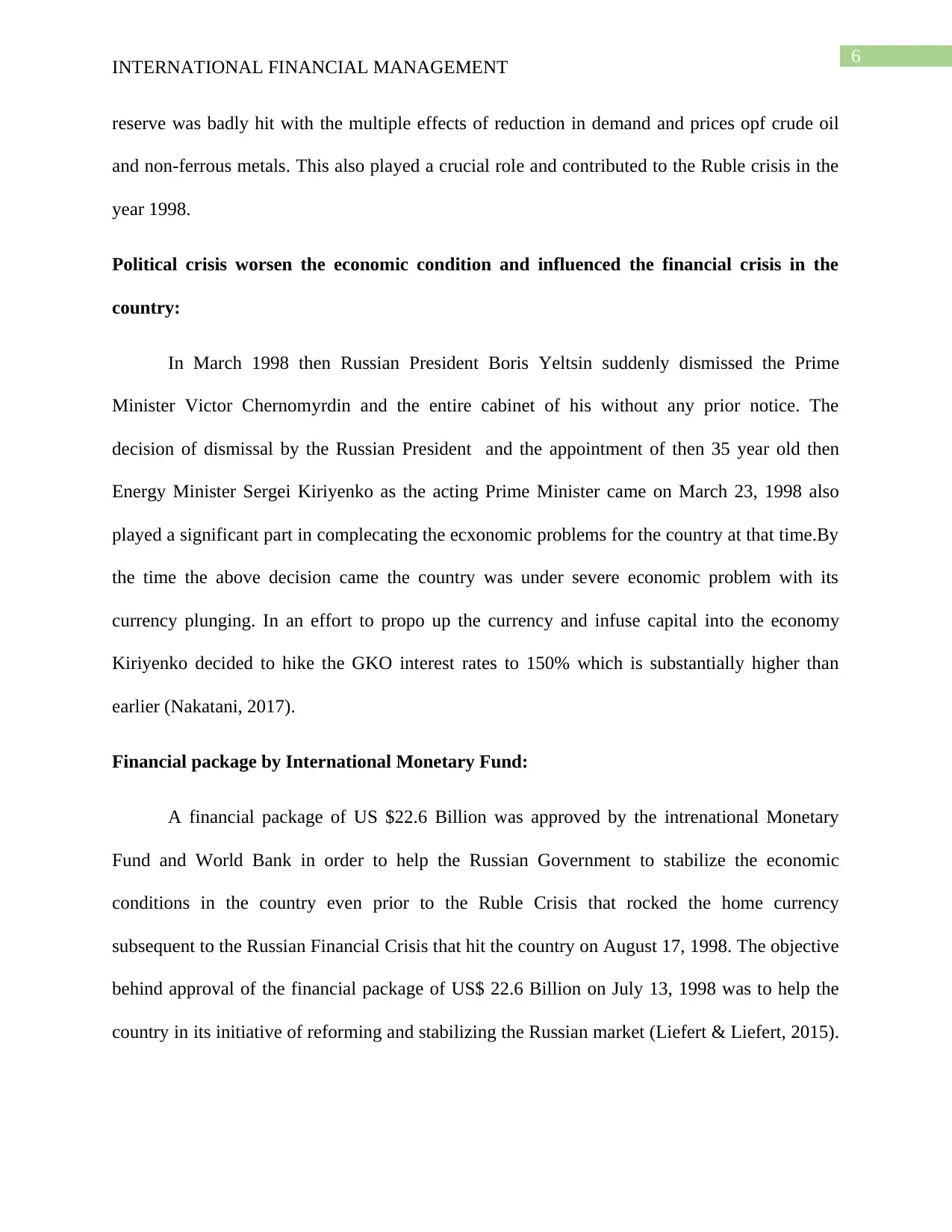
6
INTERNATIONAL FINANCIAL MANAGEMENT
reserve was badly hit with the multiple effects of reduction in demand and prices opf crude oil
and non-ferrous metals. This also played a crucial role and contributed to the Ruble crisis in the
year 1998.
Political crisis worsen the economic condition and influenced the financial crisis in the
country:
In March 1998 then Russian President Boris Yeltsin suddenly dismissed the Prime
Minister Victor Chernomyrdin and the entire cabinet of his without any prior notice. The
decision of dismissal by the Russian President and the appointment of then 35 year old then
Energy Minister Sergei Kiriyenko as the acting Prime Minister came on March 23, 1998 also
played a significant part in complecating the ecxonomic problems for the country at that time.By
the time the above decision came the country was under severe economic problem with its
currency plunging. In an effort to propo up the currency and infuse capital into the economy
Kiriyenko decided to hike the GKO interest rates to 150% which is substantially higher than
earlier (Nakatani, 2017).
Financial package by International Monetary Fund:
A financial package of US $22.6 Billion was approved by the intrenational Monetary
Fund and World Bank in order to help the Russian Government to stabilize the economic
conditions in the country even prior to the Ruble Crisis that rocked the home currency
subsequent to the Russian Financial Crisis that hit the country on August 17, 1998. The objective
behind approval of the financial package of US$ 22.6 Billion on July 13, 1998 was to help the
country in its initiative of reforming and stabilizing the Russian market (Liefert & Liefert, 2015).
INTERNATIONAL FINANCIAL MANAGEMENT
reserve was badly hit with the multiple effects of reduction in demand and prices opf crude oil
and non-ferrous metals. This also played a crucial role and contributed to the Ruble crisis in the
year 1998.
Political crisis worsen the economic condition and influenced the financial crisis in the
country:
In March 1998 then Russian President Boris Yeltsin suddenly dismissed the Prime
Minister Victor Chernomyrdin and the entire cabinet of his without any prior notice. The
decision of dismissal by the Russian President and the appointment of then 35 year old then
Energy Minister Sergei Kiriyenko as the acting Prime Minister came on March 23, 1998 also
played a significant part in complecating the ecxonomic problems for the country at that time.By
the time the above decision came the country was under severe economic problem with its
currency plunging. In an effort to propo up the currency and infuse capital into the economy
Kiriyenko decided to hike the GKO interest rates to 150% which is substantially higher than
earlier (Nakatani, 2017).
Financial package by International Monetary Fund:
A financial package of US $22.6 Billion was approved by the intrenational Monetary
Fund and World Bank in order to help the Russian Government to stabilize the economic
conditions in the country even prior to the Ruble Crisis that rocked the home currency
subsequent to the Russian Financial Crisis that hit the country on August 17, 1998. The objective
behind approval of the financial package of US$ 22.6 Billion on July 13, 1998 was to help the
country in its initiative of reforming and stabilizing the Russian market (Liefert & Liefert, 2015).
Paraphrase This Document
Need a fresh take? Get an instant paraphrase of this document with our AI Paraphraser
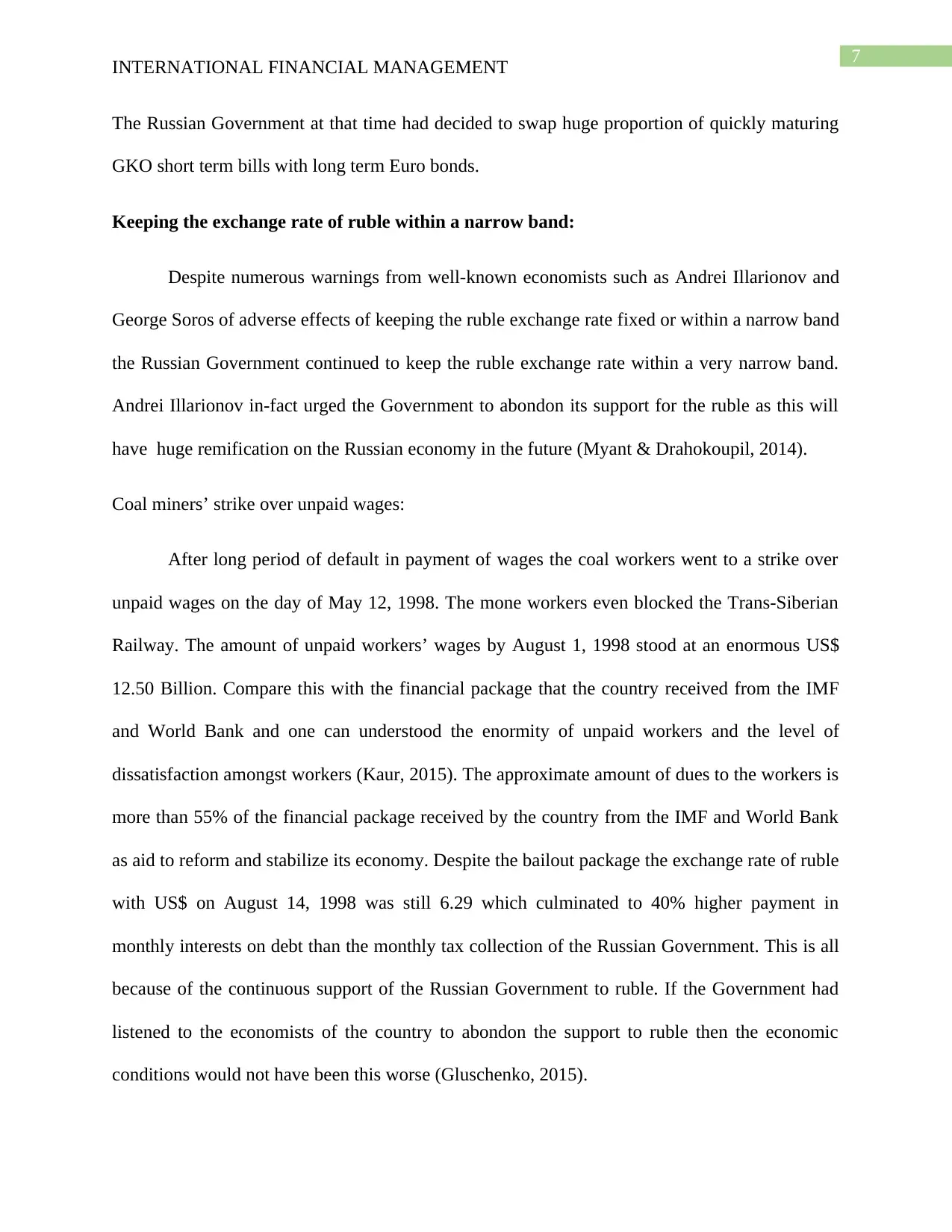
7
INTERNATIONAL FINANCIAL MANAGEMENT
The Russian Government at that time had decided to swap huge proportion of quickly maturing
GKO short term bills with long term Euro bonds.
Keeping the exchange rate of ruble within a narrow band:
Despite numerous warnings from well-known economists such as Andrei Illarionov and
George Soros of adverse effects of keeping the ruble exchange rate fixed or within a narrow band
the Russian Government continued to keep the ruble exchange rate within a very narrow band.
Andrei Illarionov in-fact urged the Government to abondon its support for the ruble as this will
have huge remification on the Russian economy in the future (Myant & Drahokoupil, 2014).
Coal miners’ strike over unpaid wages:
After long period of default in payment of wages the coal workers went to a strike over
unpaid wages on the day of May 12, 1998. The mone workers even blocked the Trans-Siberian
Railway. The amount of unpaid workers’ wages by August 1, 1998 stood at an enormous US$
12.50 Billion. Compare this with the financial package that the country received from the IMF
and World Bank and one can understood the enormity of unpaid workers and the level of
dissatisfaction amongst workers (Kaur, 2015). The approximate amount of dues to the workers is
more than 55% of the financial package received by the country from the IMF and World Bank
as aid to reform and stabilize its economy. Despite the bailout package the exchange rate of ruble
with US$ on August 14, 1998 was still 6.29 which culminated to 40% higher payment in
monthly interests on debt than the monthly tax collection of the Russian Government. This is all
because of the continuous support of the Russian Government to ruble. If the Government had
listened to the economists of the country to abondon the support to ruble then the economic
conditions would not have been this worse (Gluschenko, 2015).
INTERNATIONAL FINANCIAL MANAGEMENT
The Russian Government at that time had decided to swap huge proportion of quickly maturing
GKO short term bills with long term Euro bonds.
Keeping the exchange rate of ruble within a narrow band:
Despite numerous warnings from well-known economists such as Andrei Illarionov and
George Soros of adverse effects of keeping the ruble exchange rate fixed or within a narrow band
the Russian Government continued to keep the ruble exchange rate within a very narrow band.
Andrei Illarionov in-fact urged the Government to abondon its support for the ruble as this will
have huge remification on the Russian economy in the future (Myant & Drahokoupil, 2014).
Coal miners’ strike over unpaid wages:
After long period of default in payment of wages the coal workers went to a strike over
unpaid wages on the day of May 12, 1998. The mone workers even blocked the Trans-Siberian
Railway. The amount of unpaid workers’ wages by August 1, 1998 stood at an enormous US$
12.50 Billion. Compare this with the financial package that the country received from the IMF
and World Bank and one can understood the enormity of unpaid workers and the level of
dissatisfaction amongst workers (Kaur, 2015). The approximate amount of dues to the workers is
more than 55% of the financial package received by the country from the IMF and World Bank
as aid to reform and stabilize its economy. Despite the bailout package the exchange rate of ruble
with US$ on August 14, 1998 was still 6.29 which culminated to 40% higher payment in
monthly interests on debt than the monthly tax collection of the Russian Government. This is all
because of the continuous support of the Russian Government to ruble. If the Government had
listened to the economists of the country to abondon the support to ruble then the economic
conditions would not have been this worse (Gluschenko, 2015).
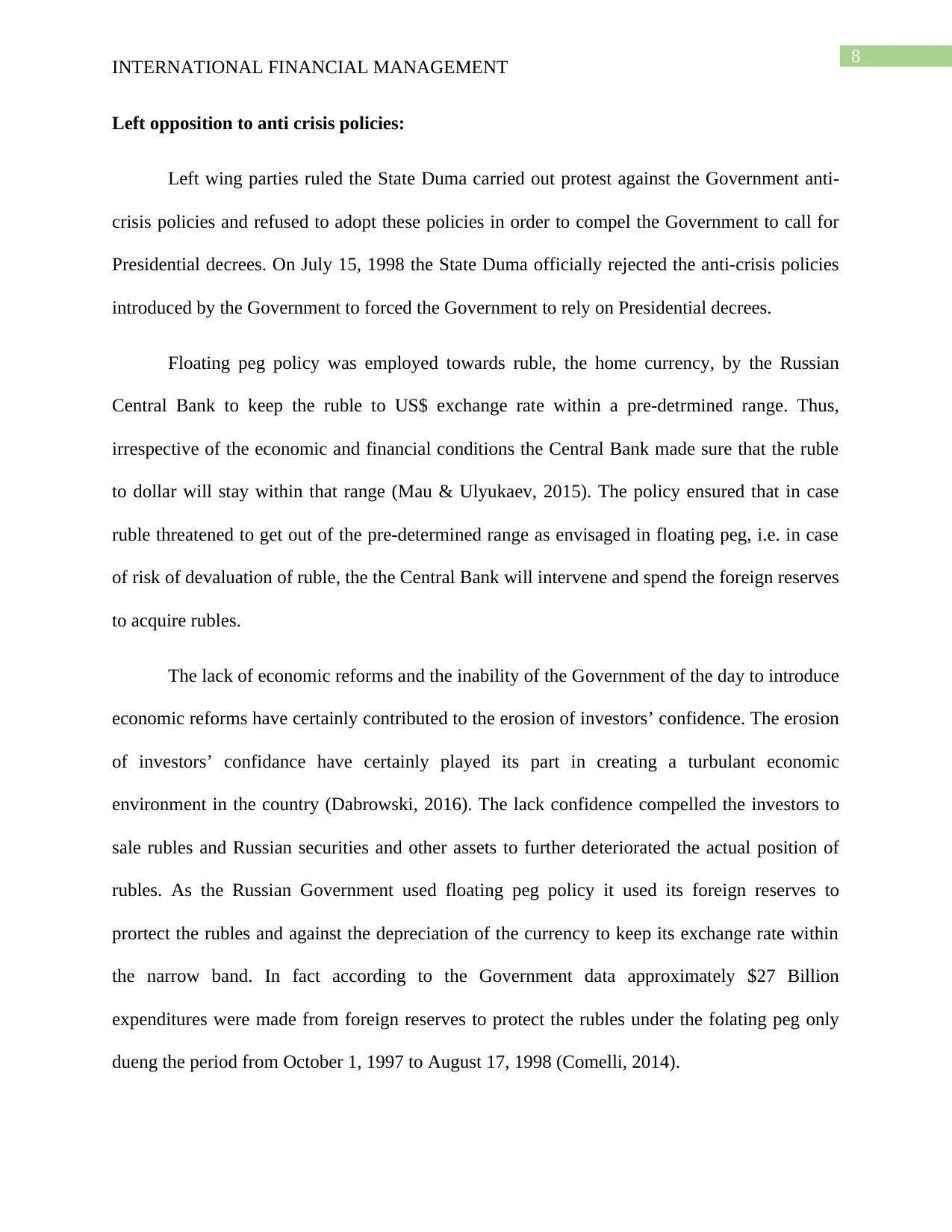
8
INTERNATIONAL FINANCIAL MANAGEMENT
Left opposition to anti crisis policies:
Left wing parties ruled the State Duma carried out protest against the Government anti-
crisis policies and refused to adopt these policies in order to compel the Government to call for
Presidential decrees. On July 15, 1998 the State Duma officially rejected the anti-crisis policies
introduced by the Government to forced the Government to rely on Presidential decrees.
Floating peg policy was employed towards ruble, the home currency, by the Russian
Central Bank to keep the ruble to US$ exchange rate within a pre-detrmined range. Thus,
irrespective of the economic and financial conditions the Central Bank made sure that the ruble
to dollar will stay within that range (Mau & Ulyukaev, 2015). The policy ensured that in case
ruble threatened to get out of the pre-determined range as envisaged in floating peg, i.e. in case
of risk of devaluation of ruble, the the Central Bank will intervene and spend the foreign reserves
to acquire rubles.
The lack of economic reforms and the inability of the Government of the day to introduce
economic reforms have certainly contributed to the erosion of investors’ confidence. The erosion
of investors’ confidance have certainly played its part in creating a turbulant economic
environment in the country (Dabrowski, 2016). The lack confidence compelled the investors to
sale rubles and Russian securities and other assets to further deteriorated the actual position of
rubles. As the Russian Government used floating peg policy it used its foreign reserves to
prortect the rubles and against the depreciation of the currency to keep its exchange rate within
the narrow band. In fact according to the Government data approximately $27 Billion
expenditures were made from foreign reserves to protect the rubles under the folating peg only
dueng the period from October 1, 1997 to August 17, 1998 (Comelli, 2014).
INTERNATIONAL FINANCIAL MANAGEMENT
Left opposition to anti crisis policies:
Left wing parties ruled the State Duma carried out protest against the Government anti-
crisis policies and refused to adopt these policies in order to compel the Government to call for
Presidential decrees. On July 15, 1998 the State Duma officially rejected the anti-crisis policies
introduced by the Government to forced the Government to rely on Presidential decrees.
Floating peg policy was employed towards ruble, the home currency, by the Russian
Central Bank to keep the ruble to US$ exchange rate within a pre-detrmined range. Thus,
irrespective of the economic and financial conditions the Central Bank made sure that the ruble
to dollar will stay within that range (Mau & Ulyukaev, 2015). The policy ensured that in case
ruble threatened to get out of the pre-determined range as envisaged in floating peg, i.e. in case
of risk of devaluation of ruble, the the Central Bank will intervene and spend the foreign reserves
to acquire rubles.
The lack of economic reforms and the inability of the Government of the day to introduce
economic reforms have certainly contributed to the erosion of investors’ confidence. The erosion
of investors’ confidance have certainly played its part in creating a turbulant economic
environment in the country (Dabrowski, 2016). The lack confidence compelled the investors to
sale rubles and Russian securities and other assets to further deteriorated the actual position of
rubles. As the Russian Government used floating peg policy it used its foreign reserves to
prortect the rubles and against the depreciation of the currency to keep its exchange rate within
the narrow band. In fact according to the Government data approximately $27 Billion
expenditures were made from foreign reserves to protect the rubles under the folating peg only
dueng the period from October 1, 1997 to August 17, 1998 (Comelli, 2014).
⊘ This is a preview!⊘
Do you want full access?
Subscribe today to unlock all pages.

Trusted by 1+ million students worldwide
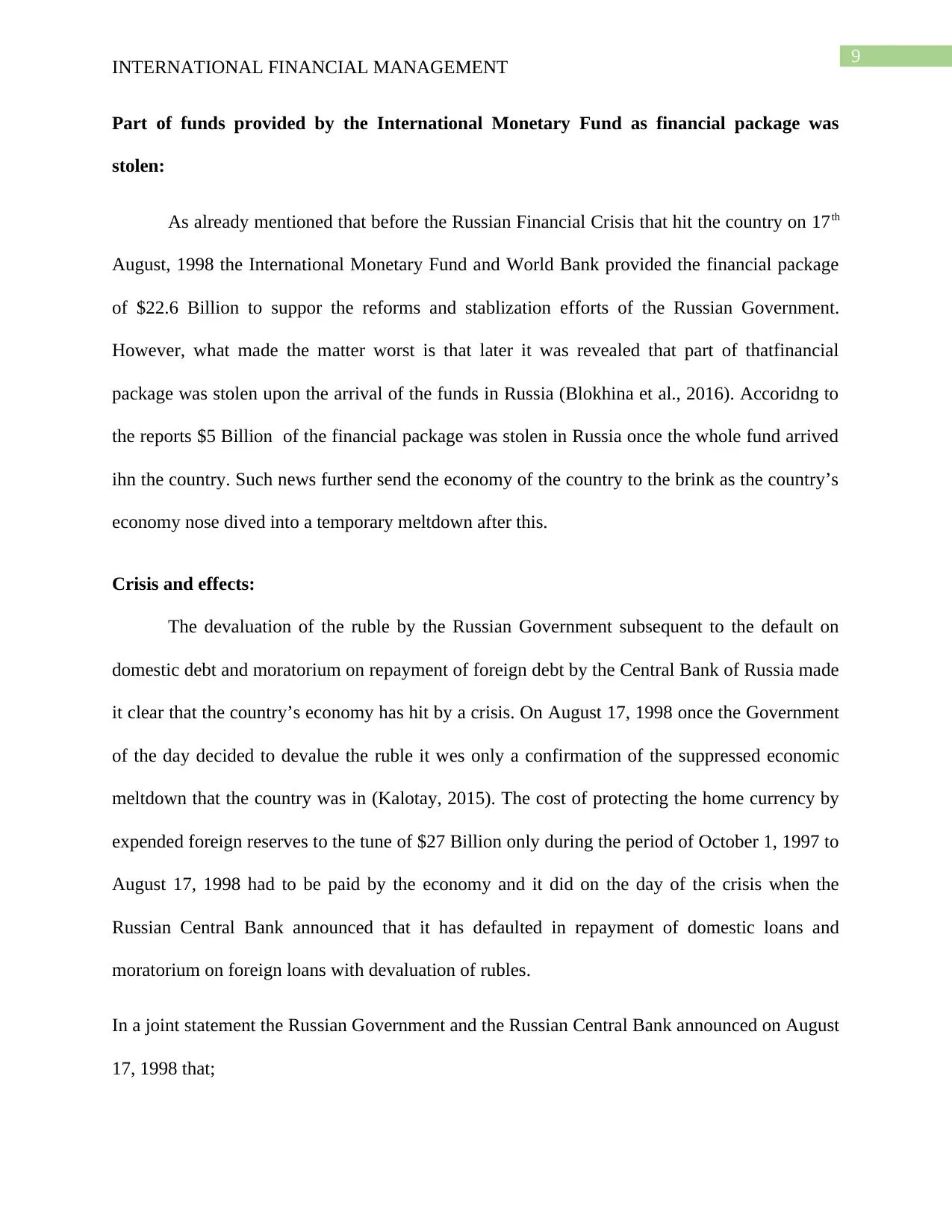
9
INTERNATIONAL FINANCIAL MANAGEMENT
Part of funds provided by the International Monetary Fund as financial package was
stolen:
As already mentioned that before the Russian Financial Crisis that hit the country on 17th
August, 1998 the International Monetary Fund and World Bank provided the financial package
of $22.6 Billion to suppor the reforms and stablization efforts of the Russian Government.
However, what made the matter worst is that later it was revealed that part of thatfinancial
package was stolen upon the arrival of the funds in Russia (Blokhina et al., 2016). Accoridng to
the reports $5 Billion of the financial package was stolen in Russia once the whole fund arrived
ihn the country. Such news further send the economy of the country to the brink as the country’s
economy nose dived into a temporary meltdown after this.
Crisis and effects:
The devaluation of the ruble by the Russian Government subsequent to the default on
domestic debt and moratorium on repayment of foreign debt by the Central Bank of Russia made
it clear that the country’s economy has hit by a crisis. On August 17, 1998 once the Government
of the day decided to devalue the ruble it wes only a confirmation of the suppressed economic
meltdown that the country was in (Kalotay, 2015). The cost of protecting the home currency by
expended foreign reserves to the tune of $27 Billion only during the period of October 1, 1997 to
August 17, 1998 had to be paid by the economy and it did on the day of the crisis when the
Russian Central Bank announced that it has defaulted in repayment of domestic loans and
moratorium on foreign loans with devaluation of rubles.
In a joint statement the Russian Government and the Russian Central Bank announced on August
17, 1998 that;
INTERNATIONAL FINANCIAL MANAGEMENT
Part of funds provided by the International Monetary Fund as financial package was
stolen:
As already mentioned that before the Russian Financial Crisis that hit the country on 17th
August, 1998 the International Monetary Fund and World Bank provided the financial package
of $22.6 Billion to suppor the reforms and stablization efforts of the Russian Government.
However, what made the matter worst is that later it was revealed that part of thatfinancial
package was stolen upon the arrival of the funds in Russia (Blokhina et al., 2016). Accoridng to
the reports $5 Billion of the financial package was stolen in Russia once the whole fund arrived
ihn the country. Such news further send the economy of the country to the brink as the country’s
economy nose dived into a temporary meltdown after this.
Crisis and effects:
The devaluation of the ruble by the Russian Government subsequent to the default on
domestic debt and moratorium on repayment of foreign debt by the Central Bank of Russia made
it clear that the country’s economy has hit by a crisis. On August 17, 1998 once the Government
of the day decided to devalue the ruble it wes only a confirmation of the suppressed economic
meltdown that the country was in (Kalotay, 2015). The cost of protecting the home currency by
expended foreign reserves to the tune of $27 Billion only during the period of October 1, 1997 to
August 17, 1998 had to be paid by the economy and it did on the day of the crisis when the
Russian Central Bank announced that it has defaulted in repayment of domestic loans and
moratorium on foreign loans with devaluation of rubles.
In a joint statement the Russian Government and the Russian Central Bank announced on August
17, 1998 that;
Paraphrase This Document
Need a fresh take? Get an instant paraphrase of this document with our AI Paraphraser
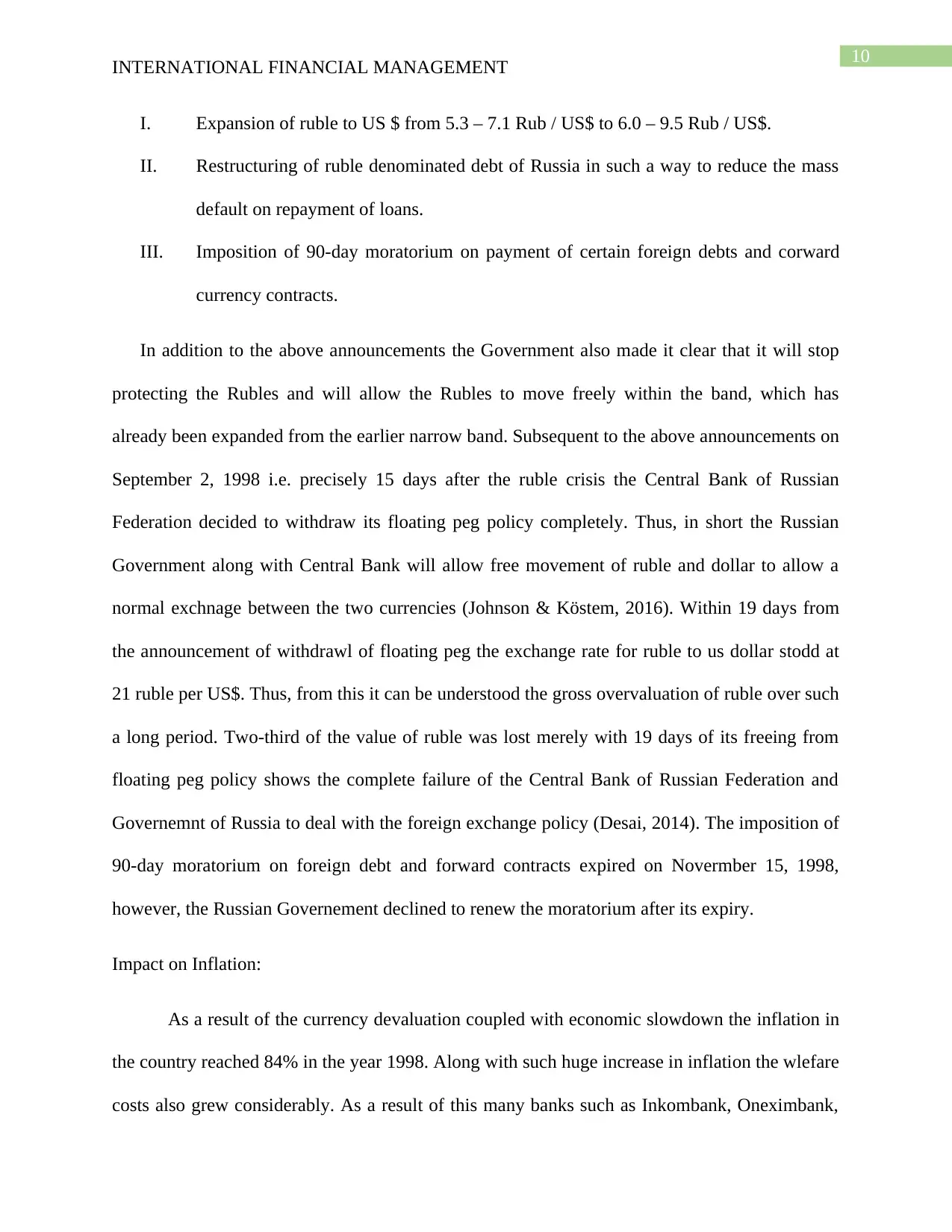
10
INTERNATIONAL FINANCIAL MANAGEMENT
I. Expansion of ruble to US $ from 5.3 – 7.1 Rub / US$ to 6.0 – 9.5 Rub / US$.
II. Restructuring of ruble denominated debt of Russia in such a way to reduce the mass
default on repayment of loans.
III. Imposition of 90-day moratorium on payment of certain foreign debts and corward
currency contracts.
In addition to the above announcements the Government also made it clear that it will stop
protecting the Rubles and will allow the Rubles to move freely within the band, which has
already been expanded from the earlier narrow band. Subsequent to the above announcements on
September 2, 1998 i.e. precisely 15 days after the ruble crisis the Central Bank of Russian
Federation decided to withdraw its floating peg policy completely. Thus, in short the Russian
Government along with Central Bank will allow free movement of ruble and dollar to allow a
normal exchnage between the two currencies (Johnson & Köstem, 2016). Within 19 days from
the announcement of withdrawl of floating peg the exchange rate for ruble to us dollar stodd at
21 ruble per US$. Thus, from this it can be understood the gross overvaluation of ruble over such
a long period. Two-third of the value of ruble was lost merely with 19 days of its freeing from
floating peg policy shows the complete failure of the Central Bank of Russian Federation and
Governemnt of Russia to deal with the foreign exchange policy (Desai, 2014). The imposition of
90-day moratorium on foreign debt and forward contracts expired on Novermber 15, 1998,
however, the Russian Governement declined to renew the moratorium after its expiry.
Impact on Inflation:
As a result of the currency devaluation coupled with economic slowdown the inflation in
the country reached 84% in the year 1998. Along with such huge increase in inflation the wlefare
costs also grew considerably. As a result of this many banks such as Inkombank, Oneximbank,
INTERNATIONAL FINANCIAL MANAGEMENT
I. Expansion of ruble to US $ from 5.3 – 7.1 Rub / US$ to 6.0 – 9.5 Rub / US$.
II. Restructuring of ruble denominated debt of Russia in such a way to reduce the mass
default on repayment of loans.
III. Imposition of 90-day moratorium on payment of certain foreign debts and corward
currency contracts.
In addition to the above announcements the Government also made it clear that it will stop
protecting the Rubles and will allow the Rubles to move freely within the band, which has
already been expanded from the earlier narrow band. Subsequent to the above announcements on
September 2, 1998 i.e. precisely 15 days after the ruble crisis the Central Bank of Russian
Federation decided to withdraw its floating peg policy completely. Thus, in short the Russian
Government along with Central Bank will allow free movement of ruble and dollar to allow a
normal exchnage between the two currencies (Johnson & Köstem, 2016). Within 19 days from
the announcement of withdrawl of floating peg the exchange rate for ruble to us dollar stodd at
21 ruble per US$. Thus, from this it can be understood the gross overvaluation of ruble over such
a long period. Two-third of the value of ruble was lost merely with 19 days of its freeing from
floating peg policy shows the complete failure of the Central Bank of Russian Federation and
Governemnt of Russia to deal with the foreign exchange policy (Desai, 2014). The imposition of
90-day moratorium on foreign debt and forward contracts expired on Novermber 15, 1998,
however, the Russian Governement declined to renew the moratorium after its expiry.
Impact on Inflation:
As a result of the currency devaluation coupled with economic slowdown the inflation in
the country reached 84% in the year 1998. Along with such huge increase in inflation the wlefare
costs also grew considerably. As a result of this many banks such as Inkombank, Oneximbank,
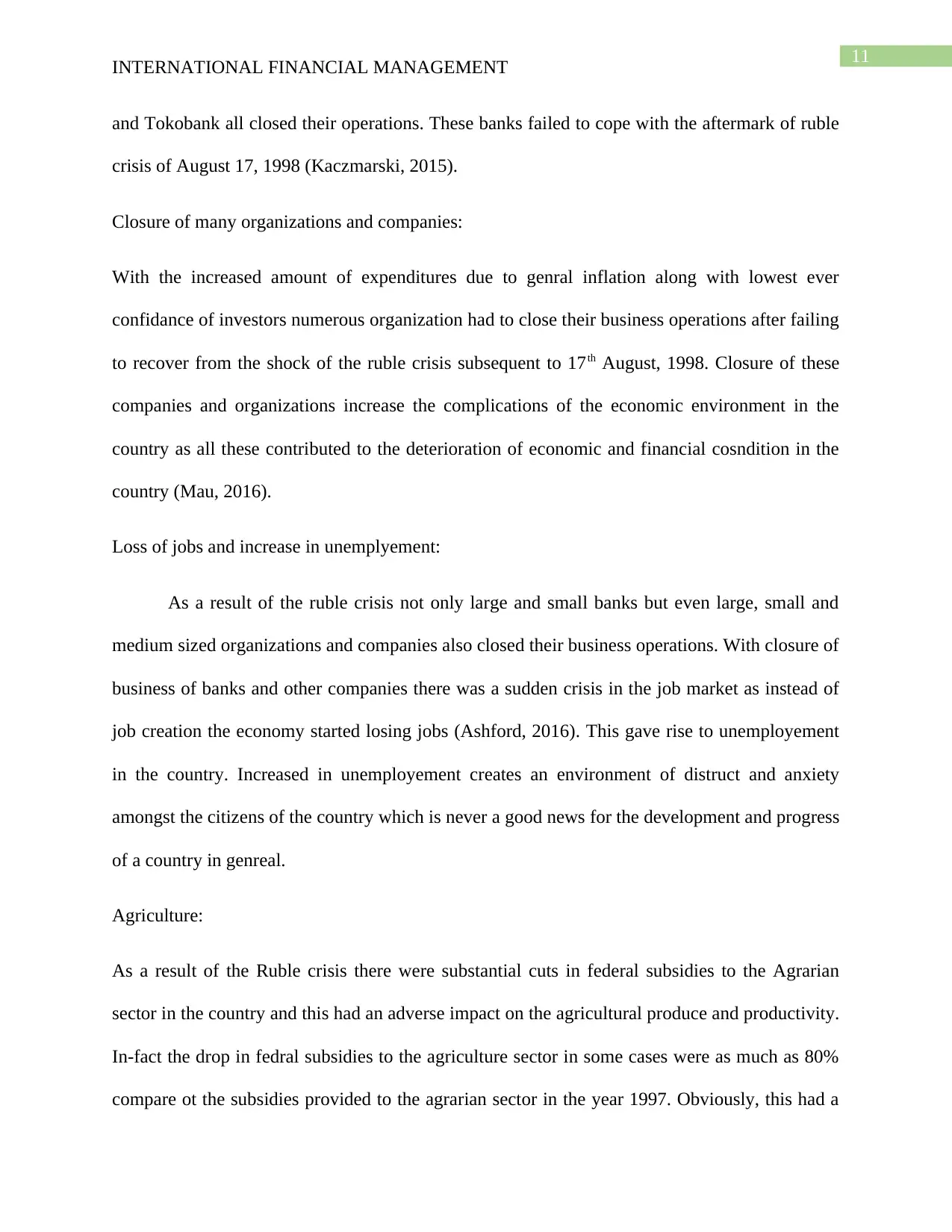
11
INTERNATIONAL FINANCIAL MANAGEMENT
and Tokobank all closed their operations. These banks failed to cope with the aftermark of ruble
crisis of August 17, 1998 (Kaczmarski, 2015).
Closure of many organizations and companies:
With the increased amount of expenditures due to genral inflation along with lowest ever
confidance of investors numerous organization had to close their business operations after failing
to recover from the shock of the ruble crisis subsequent to 17th August, 1998. Closure of these
companies and organizations increase the complications of the economic environment in the
country as all these contributed to the deterioration of economic and financial cosndition in the
country (Mau, 2016).
Loss of jobs and increase in unemplyement:
As a result of the ruble crisis not only large and small banks but even large, small and
medium sized organizations and companies also closed their business operations. With closure of
business of banks and other companies there was a sudden crisis in the job market as instead of
job creation the economy started losing jobs (Ashford, 2016). This gave rise to unemployement
in the country. Increased in unemployement creates an environment of distruct and anxiety
amongst the citizens of the country which is never a good news for the development and progress
of a country in genreal.
Agriculture:
As a result of the Ruble crisis there were substantial cuts in federal subsidies to the Agrarian
sector in the country and this had an adverse impact on the agricultural produce and productivity.
In-fact the drop in fedral subsidies to the agriculture sector in some cases were as much as 80%
compare ot the subsidies provided to the agrarian sector in the year 1997. Obviously, this had a
INTERNATIONAL FINANCIAL MANAGEMENT
and Tokobank all closed their operations. These banks failed to cope with the aftermark of ruble
crisis of August 17, 1998 (Kaczmarski, 2015).
Closure of many organizations and companies:
With the increased amount of expenditures due to genral inflation along with lowest ever
confidance of investors numerous organization had to close their business operations after failing
to recover from the shock of the ruble crisis subsequent to 17th August, 1998. Closure of these
companies and organizations increase the complications of the economic environment in the
country as all these contributed to the deterioration of economic and financial cosndition in the
country (Mau, 2016).
Loss of jobs and increase in unemplyement:
As a result of the ruble crisis not only large and small banks but even large, small and
medium sized organizations and companies also closed their business operations. With closure of
business of banks and other companies there was a sudden crisis in the job market as instead of
job creation the economy started losing jobs (Ashford, 2016). This gave rise to unemployement
in the country. Increased in unemployement creates an environment of distruct and anxiety
amongst the citizens of the country which is never a good news for the development and progress
of a country in genreal.
Agriculture:
As a result of the Ruble crisis there were substantial cuts in federal subsidies to the Agrarian
sector in the country and this had an adverse impact on the agricultural produce and productivity.
In-fact the drop in fedral subsidies to the agriculture sector in some cases were as much as 80%
compare ot the subsidies provided to the agrarian sector in the year 1997. Obviously, this had a
⊘ This is a preview!⊘
Do you want full access?
Subscribe today to unlock all pages.

Trusted by 1+ million students worldwide
1 out of 21
Related Documents
Your All-in-One AI-Powered Toolkit for Academic Success.
+13062052269
info@desklib.com
Available 24*7 on WhatsApp / Email
![[object Object]](/_next/static/media/star-bottom.7253800d.svg)
Unlock your academic potential
Copyright © 2020–2025 A2Z Services. All Rights Reserved. Developed and managed by ZUCOL.





